Analysis of Situational Awareness in Autonomous Vehicle Systems
VerifiedAdded on 2022/10/14
|8
|1478
|386
Report
AI Summary
This report delves into the critical topic of situational awareness within autonomous vehicles, focusing on both the internal and external environmental factors that influence their performance. The research highlights road safety issues and the challenges autonomous vehicles face, particularly in identifying moving obstacles. The report aims to analyze data fusion models and external situational awareness to mitigate these issues. The research methodology employs a mixed-methods approach, combining qualitative and quantitative data collection techniques, including online surveys with drivers of autonomous vehicles and interviews with senior drivers. The project timeline outlines key stages, from research planning and literature review to data collection, analysis, and conclusion. The findings aim to identify and recommend strategies for enhancing situational awareness, ultimately contributing to improved road safety and the advancement of autonomous vehicle technology. Ethical considerations, including data protection, are also addressed.
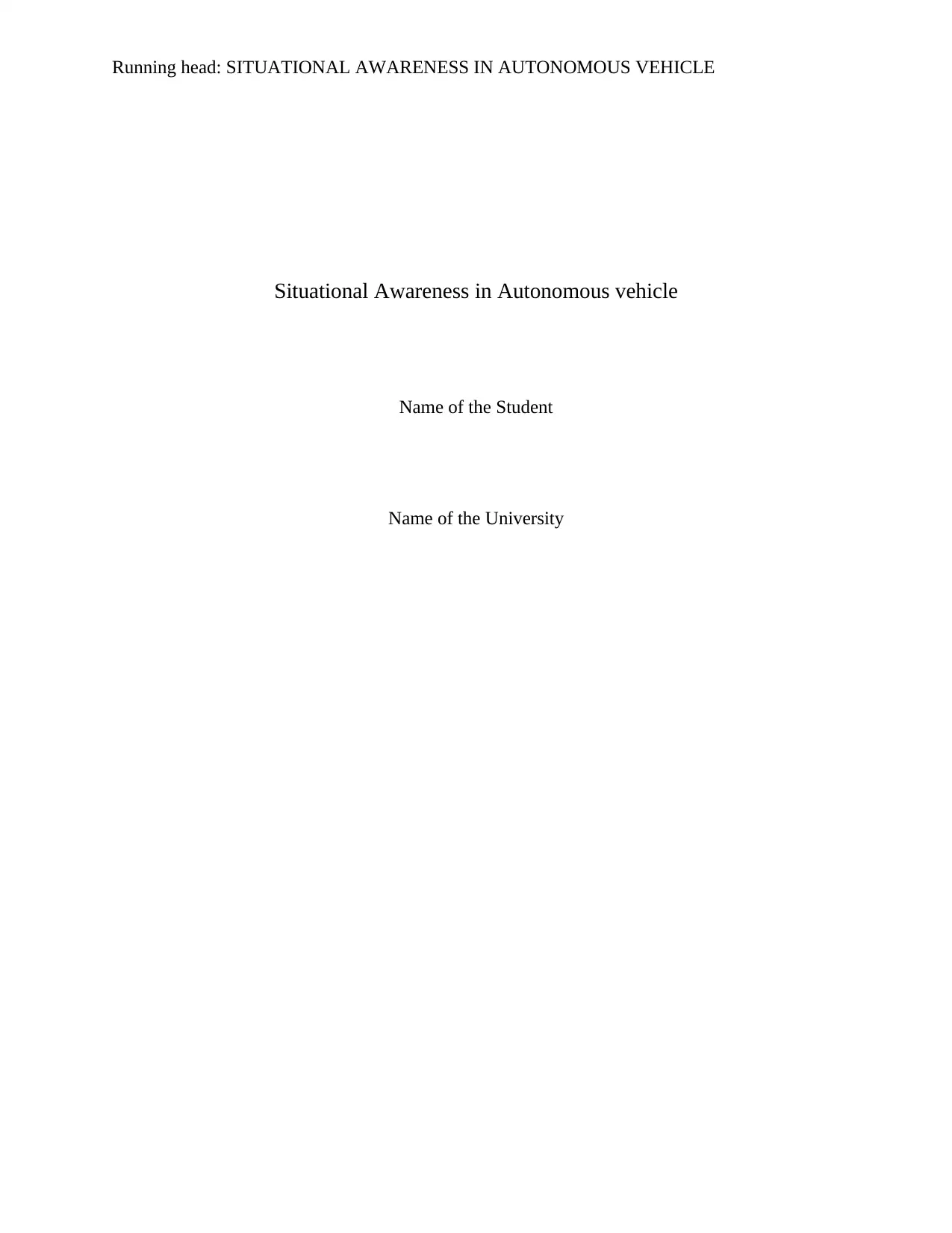
Running head: SITUATIONAL AWARENESS IN AUTONOMOUS VEHICLE
Situational Awareness in Autonomous vehicle
Name of the Student
Name of the University
Situational Awareness in Autonomous vehicle
Name of the Student
Name of the University
Paraphrase This Document
Need a fresh take? Get an instant paraphrase of this document with our AI Paraphraser
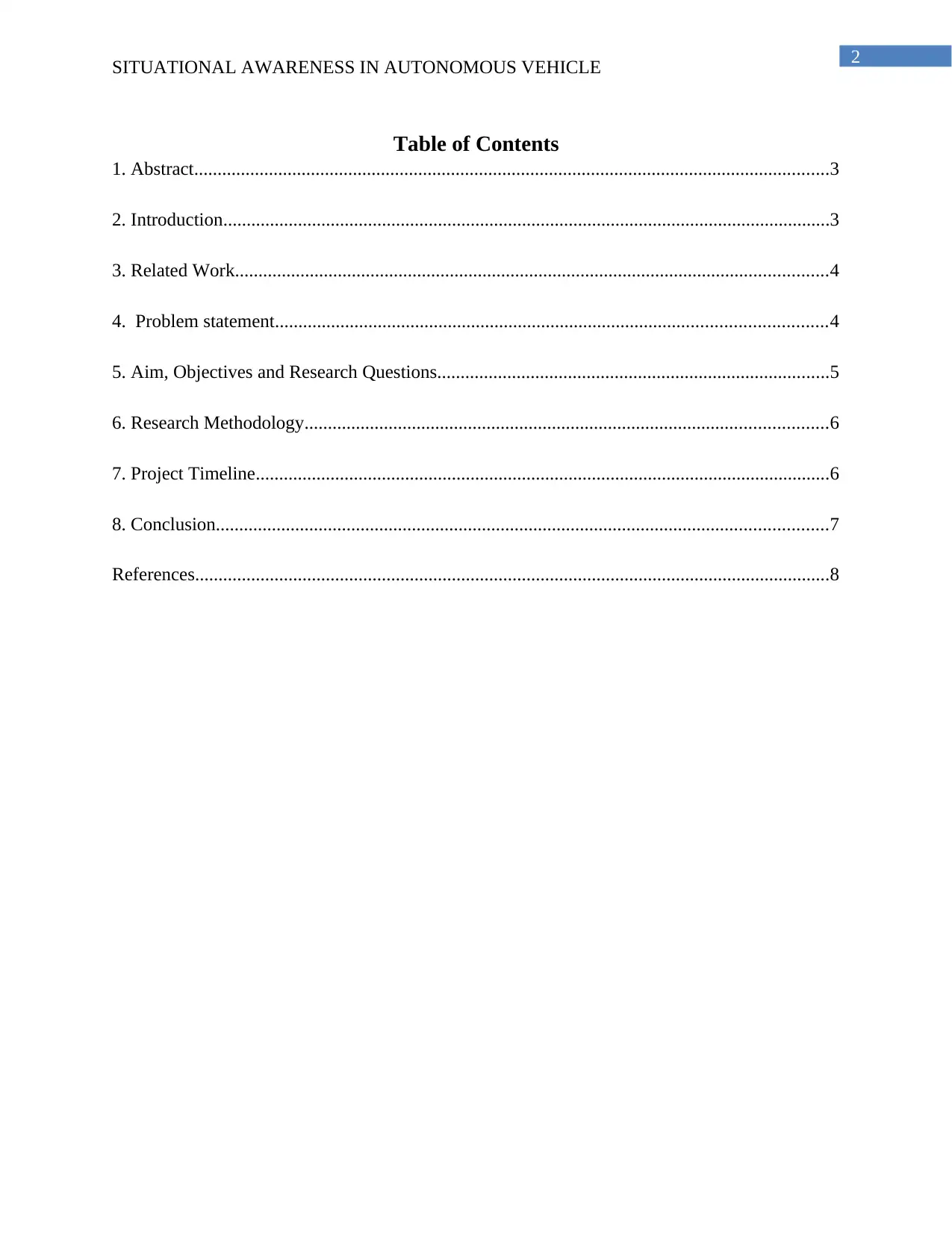
2
SITUATIONAL AWARENESS IN AUTONOMOUS VEHICLE
Table of Contents
1. Abstract........................................................................................................................................3
2. Introduction..................................................................................................................................3
3. Related Work...............................................................................................................................4
4. Problem statement......................................................................................................................4
5. Aim, Objectives and Research Questions....................................................................................5
6. Research Methodology................................................................................................................6
7. Project Timeline...........................................................................................................................6
8. Conclusion...................................................................................................................................7
References........................................................................................................................................8
SITUATIONAL AWARENESS IN AUTONOMOUS VEHICLE
Table of Contents
1. Abstract........................................................................................................................................3
2. Introduction..................................................................................................................................3
3. Related Work...............................................................................................................................4
4. Problem statement......................................................................................................................4
5. Aim, Objectives and Research Questions....................................................................................5
6. Research Methodology................................................................................................................6
7. Project Timeline...........................................................................................................................6
8. Conclusion...................................................................................................................................7
References........................................................................................................................................8
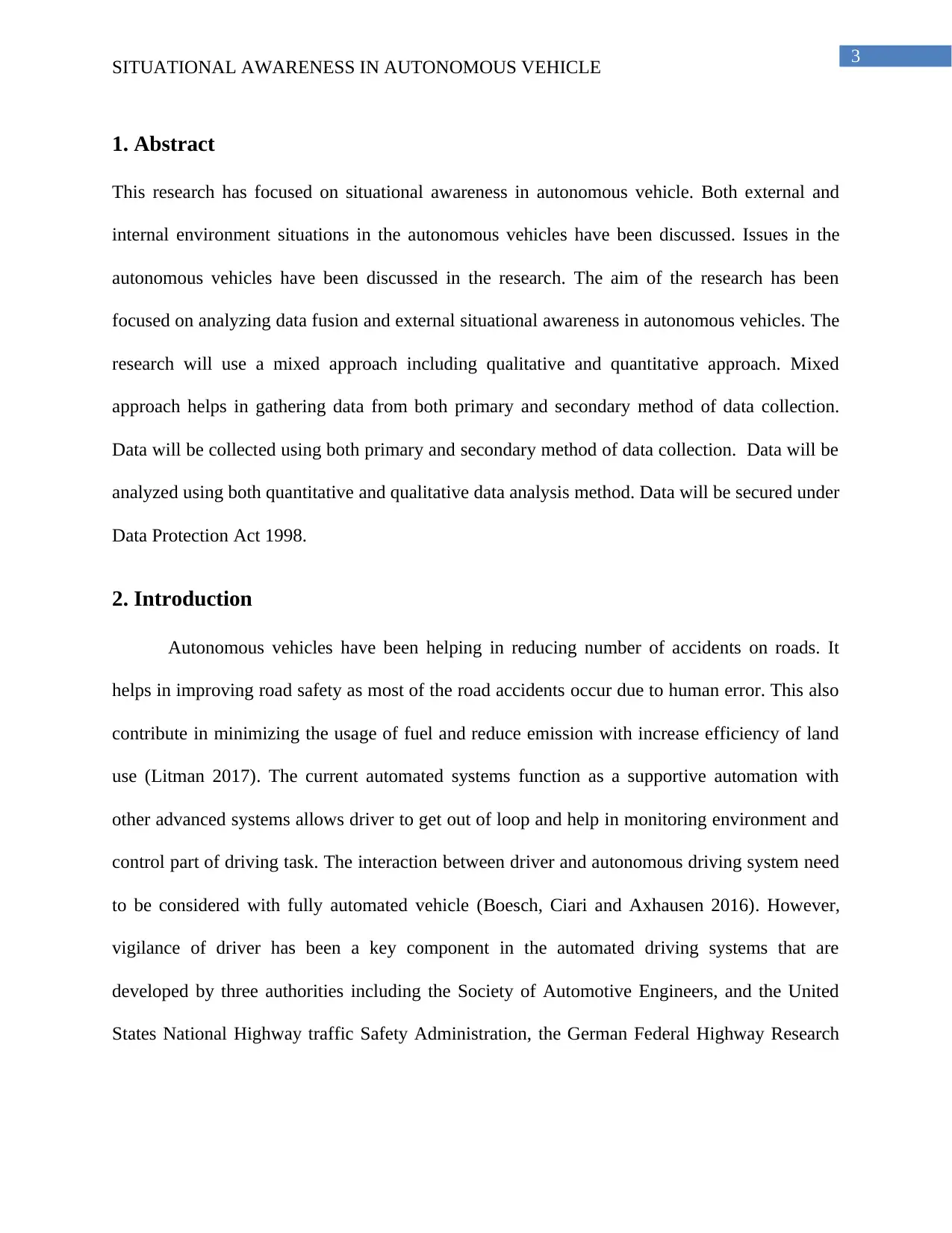
3
SITUATIONAL AWARENESS IN AUTONOMOUS VEHICLE
1. Abstract
This research has focused on situational awareness in autonomous vehicle. Both external and
internal environment situations in the autonomous vehicles have been discussed. Issues in the
autonomous vehicles have been discussed in the research. The aim of the research has been
focused on analyzing data fusion and external situational awareness in autonomous vehicles. The
research will use a mixed approach including qualitative and quantitative approach. Mixed
approach helps in gathering data from both primary and secondary method of data collection.
Data will be collected using both primary and secondary method of data collection. Data will be
analyzed using both quantitative and qualitative data analysis method. Data will be secured under
Data Protection Act 1998.
2. Introduction
Autonomous vehicles have been helping in reducing number of accidents on roads. It
helps in improving road safety as most of the road accidents occur due to human error. This also
contribute in minimizing the usage of fuel and reduce emission with increase efficiency of land
use (Litman 2017). The current automated systems function as a supportive automation with
other advanced systems allows driver to get out of loop and help in monitoring environment and
control part of driving task. The interaction between driver and autonomous driving system need
to be considered with fully automated vehicle (Boesch, Ciari and Axhausen 2016). However,
vigilance of driver has been a key component in the automated driving systems that are
developed by three authorities including the Society of Automotive Engineers, and the United
States National Highway traffic Safety Administration, the German Federal Highway Research
SITUATIONAL AWARENESS IN AUTONOMOUS VEHICLE
1. Abstract
This research has focused on situational awareness in autonomous vehicle. Both external and
internal environment situations in the autonomous vehicles have been discussed. Issues in the
autonomous vehicles have been discussed in the research. The aim of the research has been
focused on analyzing data fusion and external situational awareness in autonomous vehicles. The
research will use a mixed approach including qualitative and quantitative approach. Mixed
approach helps in gathering data from both primary and secondary method of data collection.
Data will be collected using both primary and secondary method of data collection. Data will be
analyzed using both quantitative and qualitative data analysis method. Data will be secured under
Data Protection Act 1998.
2. Introduction
Autonomous vehicles have been helping in reducing number of accidents on roads. It
helps in improving road safety as most of the road accidents occur due to human error. This also
contribute in minimizing the usage of fuel and reduce emission with increase efficiency of land
use (Litman 2017). The current automated systems function as a supportive automation with
other advanced systems allows driver to get out of loop and help in monitoring environment and
control part of driving task. The interaction between driver and autonomous driving system need
to be considered with fully automated vehicle (Boesch, Ciari and Axhausen 2016). However,
vigilance of driver has been a key component in the automated driving systems that are
developed by three authorities including the Society of Automotive Engineers, and the United
States National Highway traffic Safety Administration, the German Federal Highway Research
⊘ This is a preview!⊘
Do you want full access?
Subscribe today to unlock all pages.

Trusted by 1+ million students worldwide
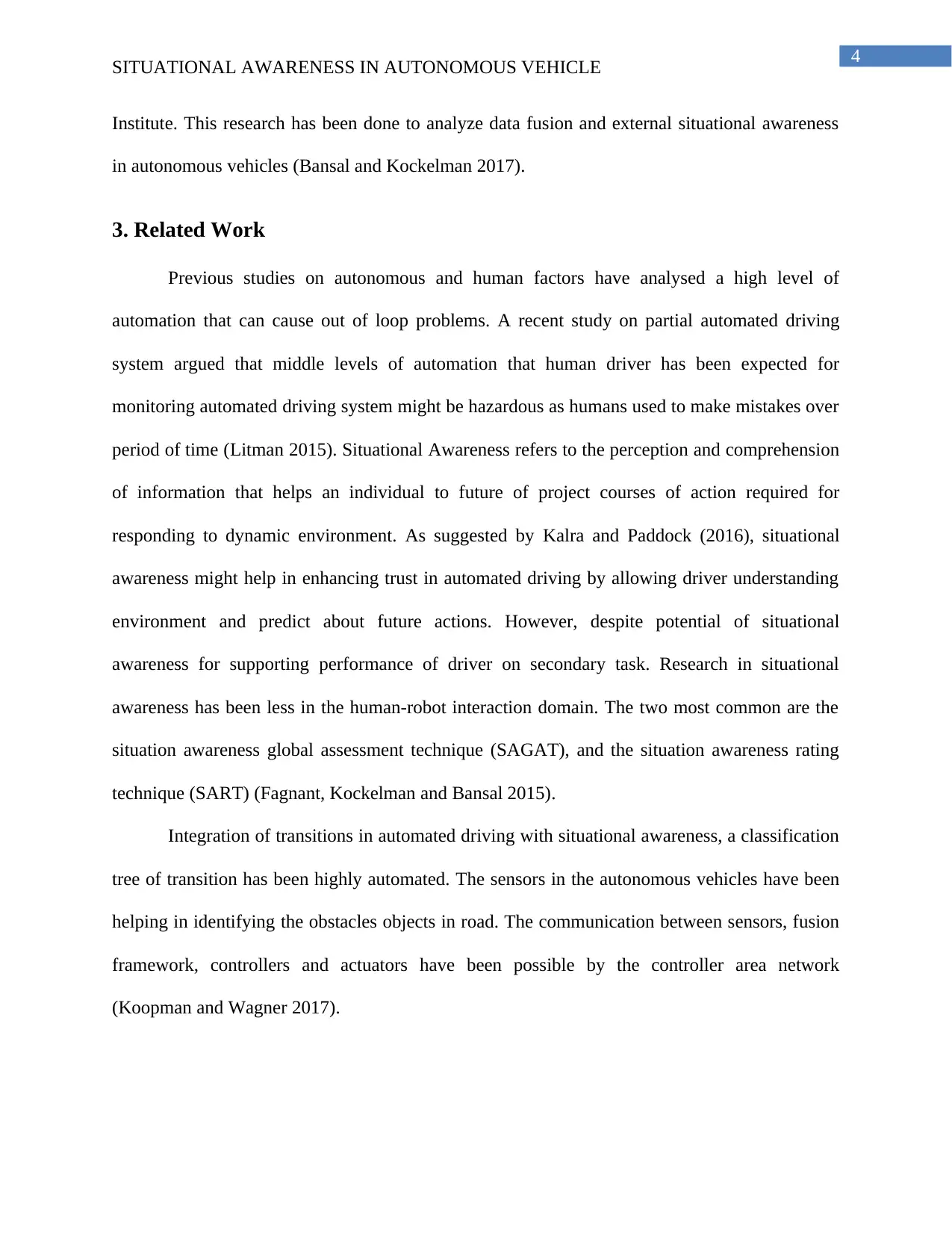
4
SITUATIONAL AWARENESS IN AUTONOMOUS VEHICLE
Institute. This research has been done to analyze data fusion and external situational awareness
in autonomous vehicles (Bansal and Kockelman 2017).
3. Related Work
Previous studies on autonomous and human factors have analysed a high level of
automation that can cause out of loop problems. A recent study on partial automated driving
system argued that middle levels of automation that human driver has been expected for
monitoring automated driving system might be hazardous as humans used to make mistakes over
period of time (Litman 2015). Situational Awareness refers to the perception and comprehension
of information that helps an individual to future of project courses of action required for
responding to dynamic environment. As suggested by Kalra and Paddock (2016), situational
awareness might help in enhancing trust in automated driving by allowing driver understanding
environment and predict about future actions. However, despite potential of situational
awareness for supporting performance of driver on secondary task. Research in situational
awareness has been less in the human-robot interaction domain. The two most common are the
situation awareness global assessment technique (SAGAT), and the situation awareness rating
technique (SART) (Fagnant, Kockelman and Bansal 2015).
Integration of transitions in automated driving with situational awareness, a classification
tree of transition has been highly automated. The sensors in the autonomous vehicles have been
helping in identifying the obstacles objects in road. The communication between sensors, fusion
framework, controllers and actuators have been possible by the controller area network
(Koopman and Wagner 2017).
SITUATIONAL AWARENESS IN AUTONOMOUS VEHICLE
Institute. This research has been done to analyze data fusion and external situational awareness
in autonomous vehicles (Bansal and Kockelman 2017).
3. Related Work
Previous studies on autonomous and human factors have analysed a high level of
automation that can cause out of loop problems. A recent study on partial automated driving
system argued that middle levels of automation that human driver has been expected for
monitoring automated driving system might be hazardous as humans used to make mistakes over
period of time (Litman 2015). Situational Awareness refers to the perception and comprehension
of information that helps an individual to future of project courses of action required for
responding to dynamic environment. As suggested by Kalra and Paddock (2016), situational
awareness might help in enhancing trust in automated driving by allowing driver understanding
environment and predict about future actions. However, despite potential of situational
awareness for supporting performance of driver on secondary task. Research in situational
awareness has been less in the human-robot interaction domain. The two most common are the
situation awareness global assessment technique (SAGAT), and the situation awareness rating
technique (SART) (Fagnant, Kockelman and Bansal 2015).
Integration of transitions in automated driving with situational awareness, a classification
tree of transition has been highly automated. The sensors in the autonomous vehicles have been
helping in identifying the obstacles objects in road. The communication between sensors, fusion
framework, controllers and actuators have been possible by the controller area network
(Koopman and Wagner 2017).
Paraphrase This Document
Need a fresh take? Get an instant paraphrase of this document with our AI Paraphraser
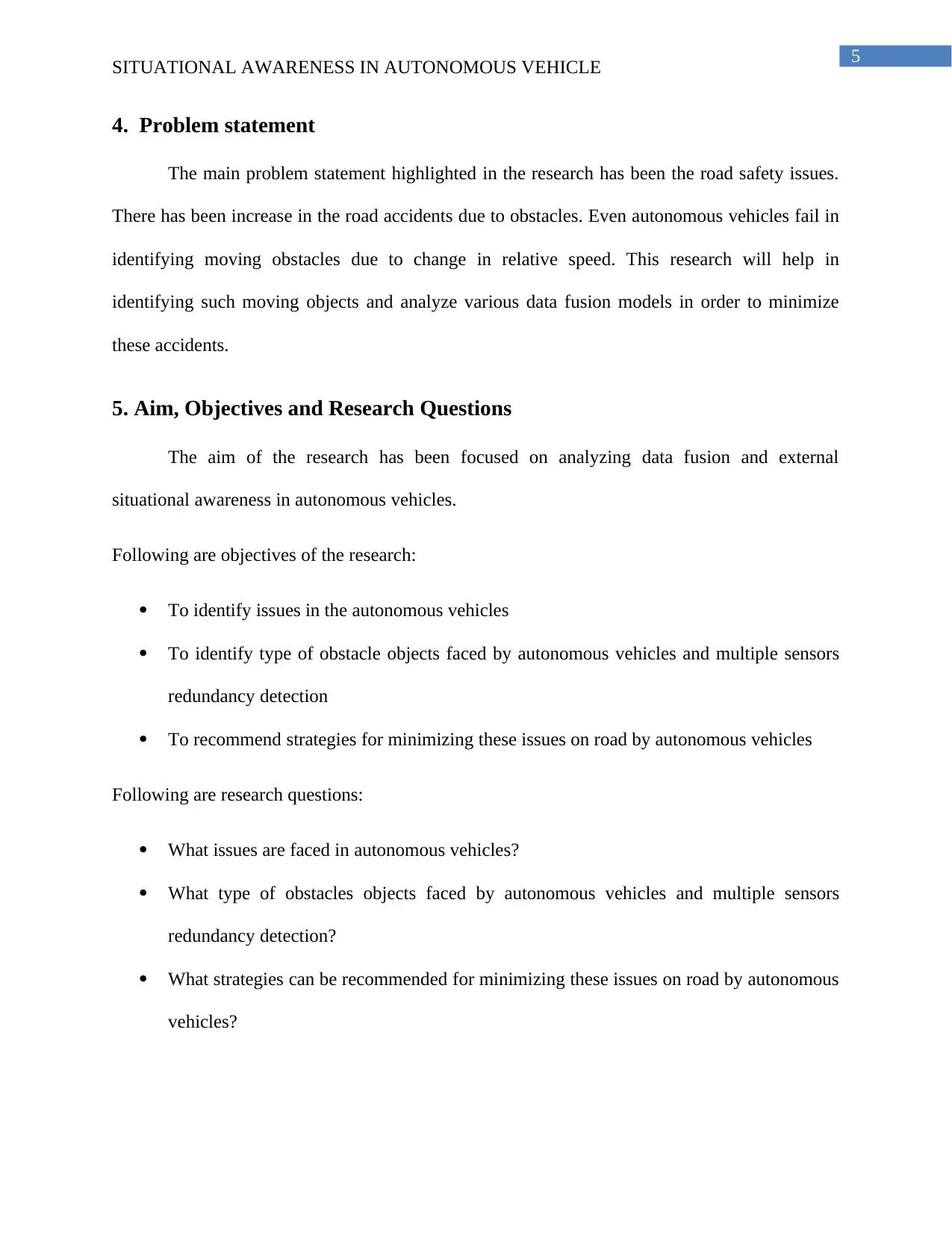
5
SITUATIONAL AWARENESS IN AUTONOMOUS VEHICLE
4. Problem statement
The main problem statement highlighted in the research has been the road safety issues.
There has been increase in the road accidents due to obstacles. Even autonomous vehicles fail in
identifying moving obstacles due to change in relative speed. This research will help in
identifying such moving objects and analyze various data fusion models in order to minimize
these accidents.
5. Aim, Objectives and Research Questions
The aim of the research has been focused on analyzing data fusion and external
situational awareness in autonomous vehicles.
Following are objectives of the research:
To identify issues in the autonomous vehicles
To identify type of obstacle objects faced by autonomous vehicles and multiple sensors
redundancy detection
To recommend strategies for minimizing these issues on road by autonomous vehicles
Following are research questions:
What issues are faced in autonomous vehicles?
What type of obstacles objects faced by autonomous vehicles and multiple sensors
redundancy detection?
What strategies can be recommended for minimizing these issues on road by autonomous
vehicles?
SITUATIONAL AWARENESS IN AUTONOMOUS VEHICLE
4. Problem statement
The main problem statement highlighted in the research has been the road safety issues.
There has been increase in the road accidents due to obstacles. Even autonomous vehicles fail in
identifying moving obstacles due to change in relative speed. This research will help in
identifying such moving objects and analyze various data fusion models in order to minimize
these accidents.
5. Aim, Objectives and Research Questions
The aim of the research has been focused on analyzing data fusion and external
situational awareness in autonomous vehicles.
Following are objectives of the research:
To identify issues in the autonomous vehicles
To identify type of obstacle objects faced by autonomous vehicles and multiple sensors
redundancy detection
To recommend strategies for minimizing these issues on road by autonomous vehicles
Following are research questions:
What issues are faced in autonomous vehicles?
What type of obstacles objects faced by autonomous vehicles and multiple sensors
redundancy detection?
What strategies can be recommended for minimizing these issues on road by autonomous
vehicles?
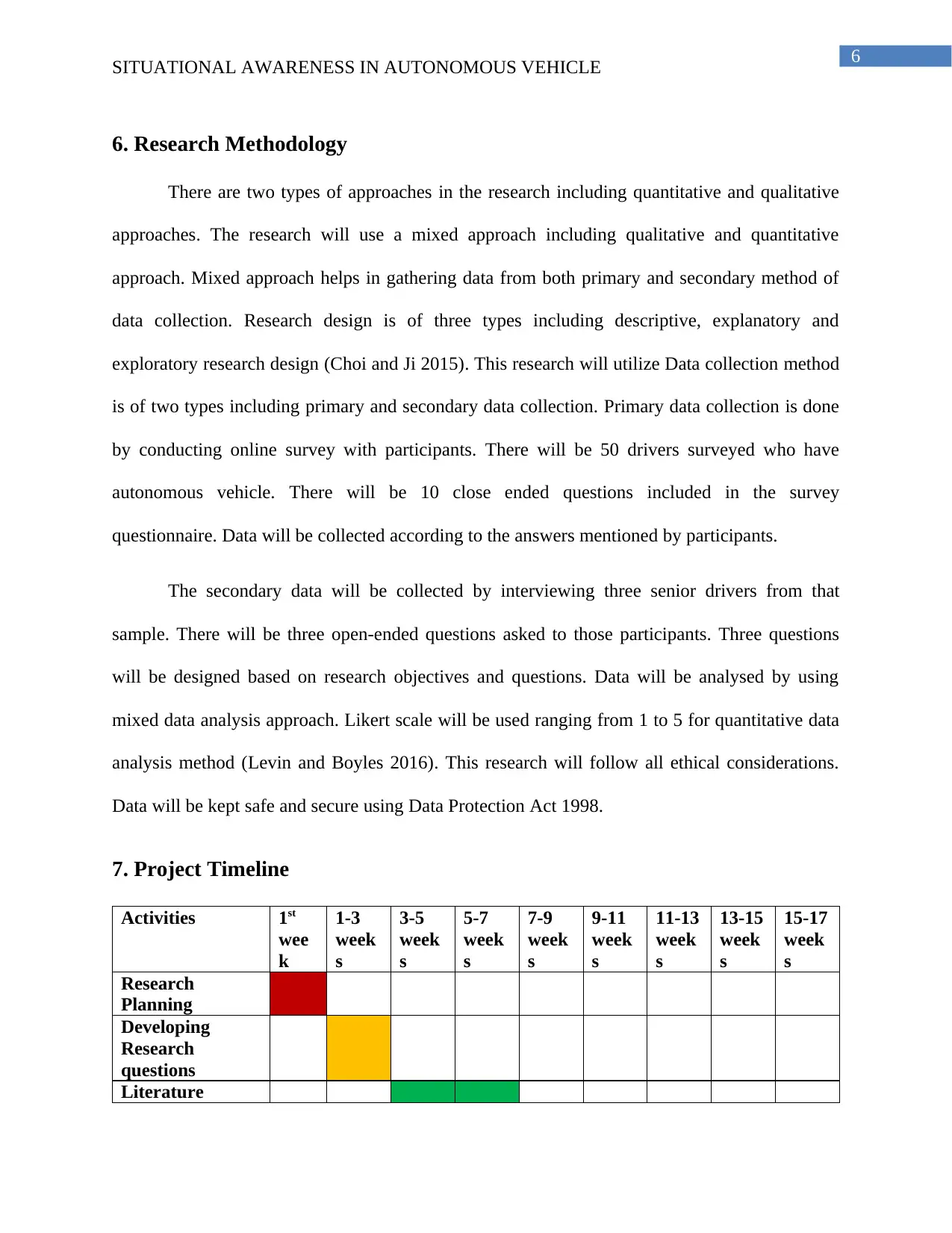
6
SITUATIONAL AWARENESS IN AUTONOMOUS VEHICLE
6. Research Methodology
There are two types of approaches in the research including quantitative and qualitative
approaches. The research will use a mixed approach including qualitative and quantitative
approach. Mixed approach helps in gathering data from both primary and secondary method of
data collection. Research design is of three types including descriptive, explanatory and
exploratory research design (Choi and Ji 2015). This research will utilize Data collection method
is of two types including primary and secondary data collection. Primary data collection is done
by conducting online survey with participants. There will be 50 drivers surveyed who have
autonomous vehicle. There will be 10 close ended questions included in the survey
questionnaire. Data will be collected according to the answers mentioned by participants.
The secondary data will be collected by interviewing three senior drivers from that
sample. There will be three open-ended questions asked to those participants. Three questions
will be designed based on research objectives and questions. Data will be analysed by using
mixed data analysis approach. Likert scale will be used ranging from 1 to 5 for quantitative data
analysis method (Levin and Boyles 2016). This research will follow all ethical considerations.
Data will be kept safe and secure using Data Protection Act 1998.
7. Project Timeline
Activities 1st
wee
k
1-3
week
s
3-5
week
s
5-7
week
s
7-9
week
s
9-11
week
s
11-13
week
s
13-15
week
s
15-17
week
s
Research
Planning
Developing
Research
questions
Literature
SITUATIONAL AWARENESS IN AUTONOMOUS VEHICLE
6. Research Methodology
There are two types of approaches in the research including quantitative and qualitative
approaches. The research will use a mixed approach including qualitative and quantitative
approach. Mixed approach helps in gathering data from both primary and secondary method of
data collection. Research design is of three types including descriptive, explanatory and
exploratory research design (Choi and Ji 2015). This research will utilize Data collection method
is of two types including primary and secondary data collection. Primary data collection is done
by conducting online survey with participants. There will be 50 drivers surveyed who have
autonomous vehicle. There will be 10 close ended questions included in the survey
questionnaire. Data will be collected according to the answers mentioned by participants.
The secondary data will be collected by interviewing three senior drivers from that
sample. There will be three open-ended questions asked to those participants. Three questions
will be designed based on research objectives and questions. Data will be analysed by using
mixed data analysis approach. Likert scale will be used ranging from 1 to 5 for quantitative data
analysis method (Levin and Boyles 2016). This research will follow all ethical considerations.
Data will be kept safe and secure using Data Protection Act 1998.
7. Project Timeline
Activities 1st
wee
k
1-3
week
s
3-5
week
s
5-7
week
s
7-9
week
s
9-11
week
s
11-13
week
s
13-15
week
s
15-17
week
s
Research
Planning
Developing
Research
questions
Literature
⊘ This is a preview!⊘
Do you want full access?
Subscribe today to unlock all pages.

Trusted by 1+ million students worldwide
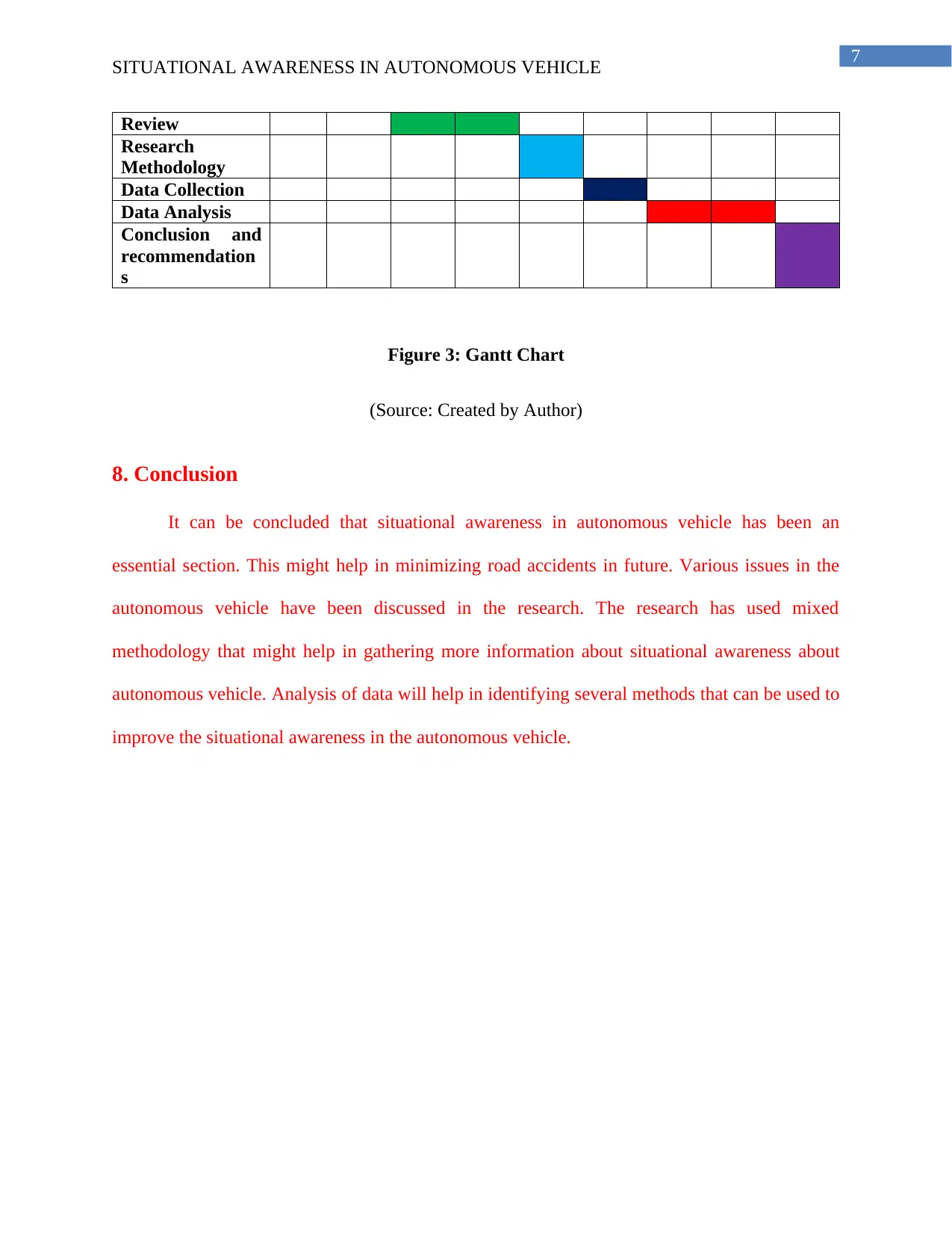
7
SITUATIONAL AWARENESS IN AUTONOMOUS VEHICLE
Review
Research
Methodology
Data Collection
Data Analysis
Conclusion and
recommendation
s
Figure 3: Gantt Chart
(Source: Created by Author)
8. Conclusion
It can be concluded that situational awareness in autonomous vehicle has been an
essential section. This might help in minimizing road accidents in future. Various issues in the
autonomous vehicle have been discussed in the research. The research has used mixed
methodology that might help in gathering more information about situational awareness about
autonomous vehicle. Analysis of data will help in identifying several methods that can be used to
improve the situational awareness in the autonomous vehicle.
SITUATIONAL AWARENESS IN AUTONOMOUS VEHICLE
Review
Research
Methodology
Data Collection
Data Analysis
Conclusion and
recommendation
s
Figure 3: Gantt Chart
(Source: Created by Author)
8. Conclusion
It can be concluded that situational awareness in autonomous vehicle has been an
essential section. This might help in minimizing road accidents in future. Various issues in the
autonomous vehicle have been discussed in the research. The research has used mixed
methodology that might help in gathering more information about situational awareness about
autonomous vehicle. Analysis of data will help in identifying several methods that can be used to
improve the situational awareness in the autonomous vehicle.
Paraphrase This Document
Need a fresh take? Get an instant paraphrase of this document with our AI Paraphraser
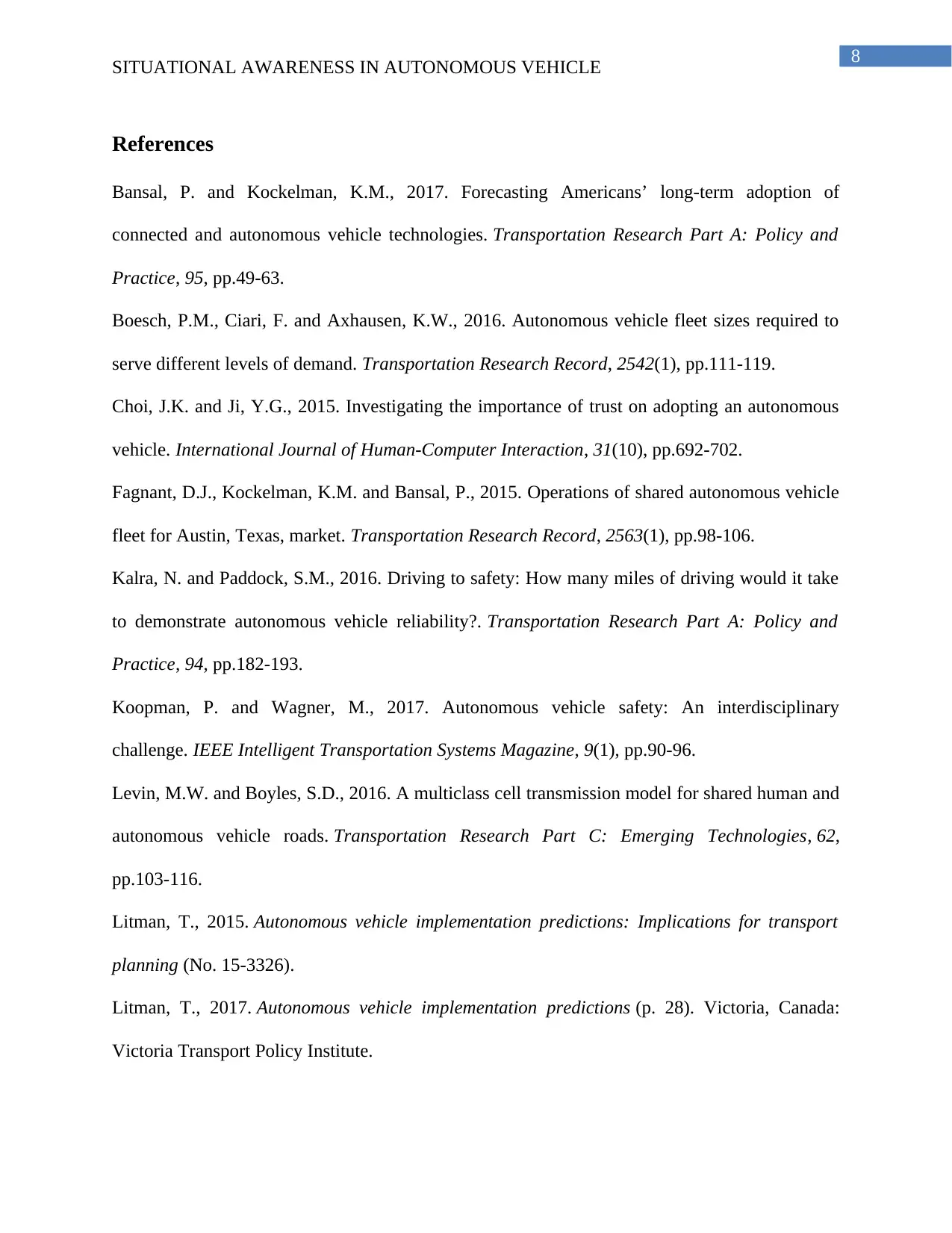
8
SITUATIONAL AWARENESS IN AUTONOMOUS VEHICLE
References
Bansal, P. and Kockelman, K.M., 2017. Forecasting Americans’ long-term adoption of
connected and autonomous vehicle technologies. Transportation Research Part A: Policy and
Practice, 95, pp.49-63.
Boesch, P.M., Ciari, F. and Axhausen, K.W., 2016. Autonomous vehicle fleet sizes required to
serve different levels of demand. Transportation Research Record, 2542(1), pp.111-119.
Choi, J.K. and Ji, Y.G., 2015. Investigating the importance of trust on adopting an autonomous
vehicle. International Journal of Human-Computer Interaction, 31(10), pp.692-702.
Fagnant, D.J., Kockelman, K.M. and Bansal, P., 2015. Operations of shared autonomous vehicle
fleet for Austin, Texas, market. Transportation Research Record, 2563(1), pp.98-106.
Kalra, N. and Paddock, S.M., 2016. Driving to safety: How many miles of driving would it take
to demonstrate autonomous vehicle reliability?. Transportation Research Part A: Policy and
Practice, 94, pp.182-193.
Koopman, P. and Wagner, M., 2017. Autonomous vehicle safety: An interdisciplinary
challenge. IEEE Intelligent Transportation Systems Magazine, 9(1), pp.90-96.
Levin, M.W. and Boyles, S.D., 2016. A multiclass cell transmission model for shared human and
autonomous vehicle roads. Transportation Research Part C: Emerging Technologies, 62,
pp.103-116.
Litman, T., 2015. Autonomous vehicle implementation predictions: Implications for transport
planning (No. 15-3326).
Litman, T., 2017. Autonomous vehicle implementation predictions (p. 28). Victoria, Canada:
Victoria Transport Policy Institute.
SITUATIONAL AWARENESS IN AUTONOMOUS VEHICLE
References
Bansal, P. and Kockelman, K.M., 2017. Forecasting Americans’ long-term adoption of
connected and autonomous vehicle technologies. Transportation Research Part A: Policy and
Practice, 95, pp.49-63.
Boesch, P.M., Ciari, F. and Axhausen, K.W., 2016. Autonomous vehicle fleet sizes required to
serve different levels of demand. Transportation Research Record, 2542(1), pp.111-119.
Choi, J.K. and Ji, Y.G., 2015. Investigating the importance of trust on adopting an autonomous
vehicle. International Journal of Human-Computer Interaction, 31(10), pp.692-702.
Fagnant, D.J., Kockelman, K.M. and Bansal, P., 2015. Operations of shared autonomous vehicle
fleet for Austin, Texas, market. Transportation Research Record, 2563(1), pp.98-106.
Kalra, N. and Paddock, S.M., 2016. Driving to safety: How many miles of driving would it take
to demonstrate autonomous vehicle reliability?. Transportation Research Part A: Policy and
Practice, 94, pp.182-193.
Koopman, P. and Wagner, M., 2017. Autonomous vehicle safety: An interdisciplinary
challenge. IEEE Intelligent Transportation Systems Magazine, 9(1), pp.90-96.
Levin, M.W. and Boyles, S.D., 2016. A multiclass cell transmission model for shared human and
autonomous vehicle roads. Transportation Research Part C: Emerging Technologies, 62,
pp.103-116.
Litman, T., 2015. Autonomous vehicle implementation predictions: Implications for transport
planning (No. 15-3326).
Litman, T., 2017. Autonomous vehicle implementation predictions (p. 28). Victoria, Canada:
Victoria Transport Policy Institute.
1 out of 8
Related Documents
Your All-in-One AI-Powered Toolkit for Academic Success.
+13062052269
info@desklib.com
Available 24*7 on WhatsApp / Email
![[object Object]](/_next/static/media/star-bottom.7253800d.svg)
Unlock your academic potential
Copyright © 2020–2025 A2Z Services. All Rights Reserved. Developed and managed by ZUCOL.





